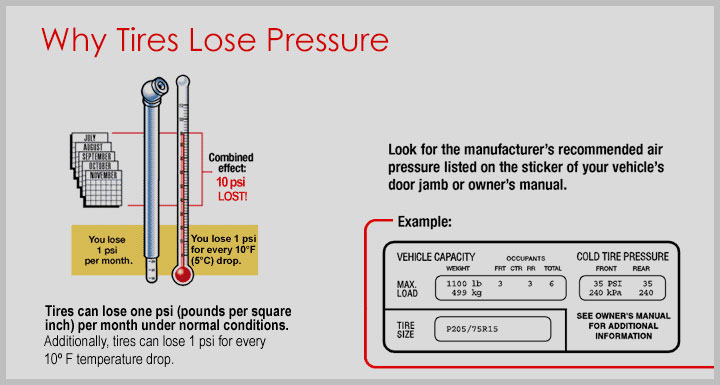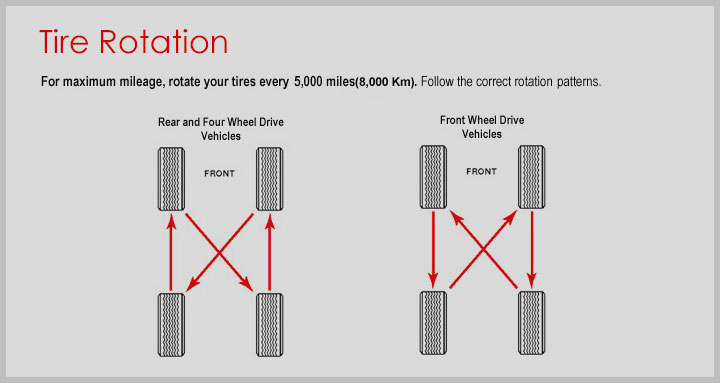Tips & Advice
Tires have been a vehicle’s most important safety feature for more than 100 years. After all, they are a vehicle’s only contact with the road. Every move a driver makes with the steering wheel, brake or gas pedal is transmitted to the road through the four notepad-sized contact patches of the tires.
So, if a consumer has tires that are worn, under-inflated, or not suited to the environment, they put themselves, their vehicle, and others at risk.
We’ve compiled a list of many areas you should consider when purchasing new tires. If you’re looking to save money, get the best fuel economy, make an informed decision, or buy the best quality tire then the information below may help.
Proper tire care and safety is simple and easy. The Rubber Manufacturers Association (RMA) recommends getting in the habit of taking five minutes every month to check your tires, including the spare. Check for:
- Pressure
- Size
- Weight
- Performance
- Balancing
- Wheel Alignment
- Rotation
- Tread
-
Maintaining proper air pressure is the one of the most important things motorists can do for their tires. In the space of just one month, a tire can lose 10 pounds (psi) of air pressure.
Tire pressures should only be checked when they are cold. Your vehicle’s recommended tire pressures are located on a placard usually on the inside edge of the driver’s door.
Overinflated tires . . .
When a tire is over inflated, the centre of the tread bears most of the load and wears out faster than the outside edges. Uneven wear reduces the useful life of a tire
- Are damaged more easily by potholes
- Lead to irregular tread wear.
- Increase internal noise levels.

-
Always check the specs of your car for the exact size. You can usually find the information you need in the manual that comes from the manufacturer. Also you can refer to the sidewall of one of your current tires.
You’ll see three numbers following “P” indicate the tire’s width in millimeters. Next, you’ll see a slash, after which, you’ll see two more numbers that tell you the percentage of the tire’s height compared to its width. The next letter, “R,” identifies the radial construction. The two numbers after it represent the diameter of the rim in inches.
-
Two tires can look the same, but they may have different load-carrying capacities. Again, check your car’s specs to determine the maximum weight your tires should carry. The manual and the decal have that information.
Take note that tires should not just support the car, but the passengers and cargo inside it. Thus, it’s not advisable to go for a new set of tires with a lower index than what your car is used to. It’s best to stick to the load index of your current tires.
You can look through the load rating sheet attached to check the exact maximum weight that corresponds to your tire’s numbers
Load Rating.
Load index
Load in Kg per tire
Load index
Load in Kg per tire
Load index
Load in Kg per tire
Load index
Load in Kg per tire
Load index
Load in Kg per tire
62
265
75
387
88
560
101
825
114
1180
63
272
76
400
89
580
102
850
115
1215
64
280
77
412
90
600
103
875
116
1250
65
290
78
425
91
615
104
900
117
1285
66
300
79
437
92
630
105
925
118
1320
67
307
80
450
93
650
106
950
119
1360
68
315
81
462
94
670
107
975
120
1400
69
325
82
475
95
690
108
1000
121
1450
70
335
83
487
96
710
109
1030
122
1500
71
345
84
500
97
730
110
1060
123
1550
72
355
85
515
98
750
111
1090
124
1600
73
365
86
530
99
775
112
1120
125
1650
74
375
87
545
100
800
113
1150
126
1700
-
Ultimately, your tires affect your car’s performance. It’s best to think about how you use your car when buying a new set of tires.
On snowy streets, equip your car with specialized snow tires.
If you drive fast, choose tires with a high-speed rating. You can determine the rating by looking at the letter beside the load index in the alphanumeric code. The range is A to Z, with A being the lowest and Z the highest.
Speed Symbol
J
K
L
M
N
P
Q
R
S
T
U
H
V
W
Y
VR
ZR
Speed in kmh
100
110
120
130
140
150
160
170
180
190
200
210
240
270
300
>210
>240
-
Having your tires balanced is important not only to the longevity of the tire, but to the safety of the driver and to the performance of the car.
Unbalanced tires cause road vibration, which leads to driver fatigue, premature tire wear and unnecessary wear to your vehicle’s suspension. Tires should be balanced when they are mounted on wheels for the first time or when they are remounted after a repair. They should be rebalanced at the first sign of a vibration or shimmy, and should be balanced at least once a year.
-
Wheel alignment is the science of precisely measuring and then positioning the wheels on your car by adjusting their angles so that they are perpendicular to the ground and parallel to each other. A proper wheel alignment will significantly extend the life of your tires When correctly set it will significantly extend the life of your tires, ensure a straight track of your vehicle, better handling, safer ride, and greater fuel economy.
Wheel alignments and rotations maximize the life of your tires by ensuring your tires wear evenly
-
Your tires should be rotated every other oil change or every 10000KM. Neglecting to rotate tires is a major cause of premature tire wear
The weight of a vehicle is not evenly distributed to all four car tires. Therefore, regular rotation is necessary to maintain even tread wear and get the most out of your tires.
There are several methods of rotation. For all-season tires and most vehicles on the road, tires from the rear axle are moved to the drive axle and crossed to opposite sides of the vehicle. The tires from the front axle are moved to the rear, but remain on the same sides. This is known as the ‘modified X’ pattern.
Tires with directional design are rotated differently. In this case, all tires remain on the same side of the vehicle and are rotated straight forward and straight back.
For 4WD vehicles, it is recommended to switch all four tires, both from side-to-side and in axle position.
Check your owner’s manual for the manufacturer’s rotation recommendations. If no rotation period is specified, tires should be adjusted every 10,000 km’s. 4WD tires may require rotation as soon as every 4,000 km’s. The first rotation of your tires is the most important.
-
Although the minimum amount of tread required for a car to be roadworthy is 1.6 mm, it’s wise to replace tires at 2 mm, as wet-weather grip is diminished when there is only a small amount of tread.
Match the same tire treads on the same axle.
Different brands grip differently which can cause handling problems if mismatched.
To check tread depth, put a match head into the tread grooves, and if any part of the head shows above the grooves it’s time to replace the tire.
Battery care and maintenance
Read more about our full range of car batteries.
Your vehicle’s battery primarily helps to start the engine. However, it also stores energy generated by the alternator, and runs the secondary electrical systems or additional components in your vehicle. To help you take care of your battery, and its longevity it would be recommended to do the following:
- Remove rust,
- Cleaning both negative and positive terminals
- Check the alternator belt tension and wear
- Control the acid’s level
- Make sure you install the correct size to your vehicle
Some Indications There is a Problem with Your Battery:
- Your vehicle won’t start.
- The vehicle is silent when you turn the key in the ignition.
- Your vehicle makes a clicking noise, but won’t start.
- The battery keeps running down.
- The battery seems weak and fails to crank your engine normally.
These are common indications that you may need a new battery or battery connections. If you experience any of these problems, schedule an appointment with your local Beaurepaires dealer


